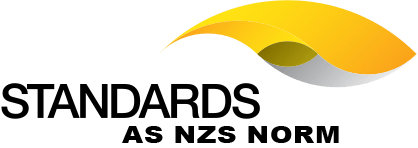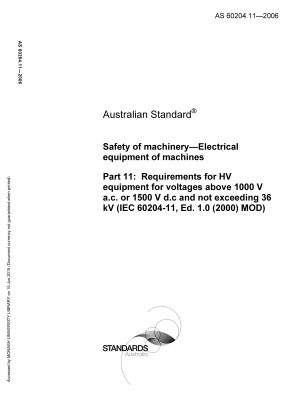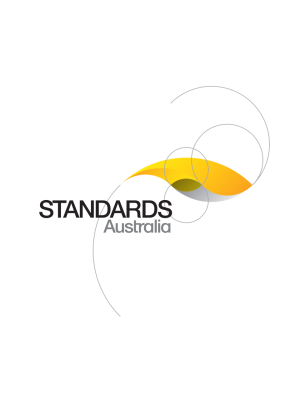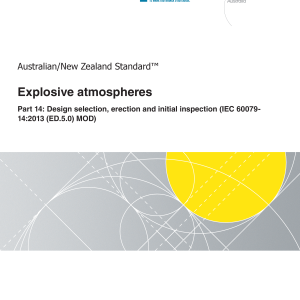🔍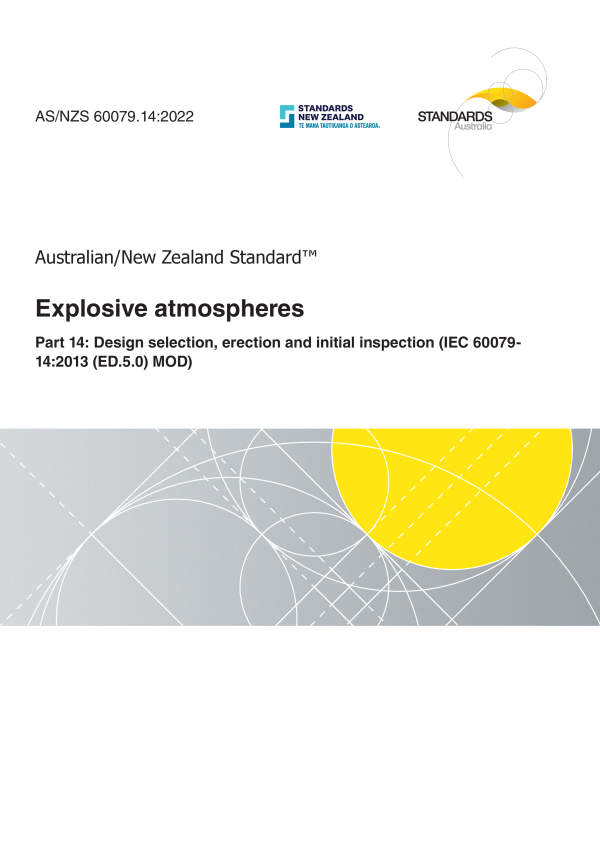

Purchase the full subscription package now and enjoy a 40% discount, along with free updates for future editions.
AS/NZS 60079.14:2022
$329.42
Explosive atmospheres, Part 14: Design selection, erection and initial inspection (IEC 60079-14:2013 (ED.5.0) MOD)
AS/NZS 60079.14:2022 adopts IEC 60079 14, setting out the specific requirements for the design, selection, erection and initial inspection of electrical installations in, or associated with, explosive atmospheres. Applies to all electrical equipment including fixed, portable, transportable and personal, and installations, permanent or temporary.
Table of contents
Header
About this publication
Preface
Introduction
1 Scope
2 Normative references
3 Terms and definitions
4 General
4.1 General requirements
4.2 Documentation
4.3 Initial inspection
4.4 Assurance of conformity of equipment
4.4.1 Equipment with certificates according to IEC standards
4.4.1.1 General
4.4.1.2 IEC standards
4.4.2 Equipment without certificates according to IEC standards
4.4.3 Selection of repaired, second hand or existing equipment
4.5 Qualifications of personnel
5 Selection of equipment
5.1 Information requirements
5.2 Zones
5.3 Relationship between equipment protection levels (EPLs) and zones
5.4 Selection of equipment according to EPLs
5.4.1 General
5.4.2 Relationship between EPLs and types of protection
5.4.3 Equipment for use in locations requiring EPL “Ga” or “Da”
5.4.4 Equipment for use in locations requiring EPL “Gb” or “Db”
5.4.5 Equipment for use in locations requiring EPL “Gc” or “Dc”
5.5 Selection according to equipment grouping
5.6 Selection according to the ignition temperature of the gas, vapour or dust and ambient temperature
5.6.1 General
5.6.2 Gas or vapour
5.6.3 Dust
5.6.3.1 General
5.6.3.2 Temperature limitations because of the presence of dust clouds
5.6.3.3 Temperature limitation because of presence of dust layers
5.6.3.4 Unavoidable dust layers
5.7 Selection of radiating equipment
5.7.1 General
5.7.2 Ignition process
5.8 Selection of ultrasonic equipment
5.8.1 General
5.8.2 Ignition process
5.9 Selection to cover external influences
5.10 Selection of transportable, portable and personal equipment
5.10.1 General
5.10.2 Transportable and portable equipment
5.10.3 Personal equipment
5.11 Rotating electrical machines
5.11.1 General
5.11.2 Environmental Factors for “Ex” machine installation
5.11.3 Power and accessory connections, grounding
5.11.4 Motors fed from a converter supply
5.11.5 Switching motors above 1kV
5.11.5.1 General
5.11.5.2 Overvoltages resulting from switching operations
5.12 Luminaires
5.13 Plugs and socket outlets
5.13.1 General
5.13.2 Specific requirements for explosive dust atmospheres
5.13.3 Location
5.14 Cells and batteries
5.14.1 Charging of secondary cells and batteries
5.14.2 Ventilation
5.15 RFID tags
5.15.1 General
5.15.2 Passive RFID tags
5.15.3 Mounting RFID tags
5.16 Gas detection equipment
6 Protection from dangerous (incendive) sparking
6.1 Light metals as construction materials
6.2 Danger from live parts
6.3 Danger from exposed and extraneous conductive parts
6.3.1 General
6.3.2 TN type of system earthing
6.3.3 TT type of system earthing
6.3.4 IT type of system earthing
6.3.5 SELV and PELV systems
6.3.6 Electrical separation
6.3.7 Non Ex electrical equipment above hazardous areas
6.4 Potential equalization
6.4.1 General
6.4.2 Temporary bonding
6.5 Static electricity
6.5.1 General
6.5.2 Avoidance of a build-up of electrostatic charge on construction and protecting parts for locations requiring EPL “Ga”, “Gb” and “Gc”
6.5.3 Avoidance of a build-up of electrostatic charge on construction and protecting parts for locations requiring EPL “Da”, “Db” and “Dc”
6.6 Lightning protection
6.7 Electromagnetic radiation
6.7.1 General
6.7.2 Radio frequency received in hazardous areas
6.8 Cathodically protected metallic parts
6.9 Ignition by optical radiation
7 Electrical protection
8 Switch-off and electrical isolation
8.1 General
8.2 Switch-off
8.3 Electrical isolation
9 Cables and wiring systems
9.1 General
9.2 Aluminium conductors
9.3 Cables
9.3.1 General
9.3.2 Cables for fixed installations
9.3.3 Flexible cables for fixed installations (excluding intrinsically safe circuits)
9.3.4 Flexible cables supplying transportable and portable equipment (excluding intrinsically safe circuits)
9.3.5 Single insulated wires (excluding intrinsically safe circuits)
9.3.6 Overhead lines
9.3.7 Avoidance of damage
9.3.8 Cable surface temperature
9.3.9 Resistance to flame propagation
9.4 Conduit systems
9.5 Additional requirements
9.6 Installation requirements
9.6.1 Circuits traversing a hazardous area
9.6.2 Terminations
9.6.3 Unused cores
9.6.4 Openings in walls
9.6.5 Passage and collection of flammables
9.6.6 Accumulation of dust
10 Cable entry systems and blanking elements
10.1 General
10.2 Selection of cable glands
10.3 Connections of cables to equipment
10.4 Additional requirements for entries other than Ex “d”, Ex “t” or Ex “nR”
10.5 Unused openings
10.6 Additional requirements for type of protection “d” – Flameproof enclosures
10.6.1 General
10.6.2 Selection of cable glands
10.7 Additional requirements for type of protection “t” – Protection by enclosure
10.8 Additional requirements for type of protection “nR” – Restricted breathing enclosure
11 Rotating electrical machines
11.1 General
11.2 Motors with type of protection “d” – Flameproof enclosures
11.2.1 Motors with a converter supply
11.2.2 Reduced-voltage starting (soft starting)
11.3 Motors with type of protection “e” – Increased safety
11.3.1 Mains-operated
11.3.2 Winding temperature sensors
11.3.3 Machines with rated voltage greater than 1 kV
11.3.4 Motors with converter supply
11.3.5 Reduced-voltage starting (soft starting)
11.4 Motors with type of protection “p” and “pD” – Pressurized enclosures
11.4.1 Motors with a converter supply
11.4.2 Reduced-voltage starting (soft starting)
11.5 Motors with type of protection “t” – Protection by enclosures supplied at varying frequency and voltage
11.5.1 Motors with a converter supply
11.5.2 Reduced-voltage starting (soft starting)
11.6 Motors with type of protection “nA” – Non-sparking
11.6.1 Motors with converter supply
11.6.2 Reduced-voltage starting (soft starting)
11.6.3 Machines with rated voltage greater than 1 kV
12 Luminaires
13 Electric heating systems
13.1 General
13.2 Temperature monitoring
13.3 Limiting temperature
13.4 Safety device
13.5 Electrical trace heating systems
14 Additional requirements for type of protection “d” – Flameproof enclosures
14.1 General
14.2 Solid obstacles
14.3 Protection of flameproof joints
14.4 Conduit systems
15 Additional requirements for type of protection “e” – Increased safety
15.1 General
15.2 Maximum dissipated power of terminal box enclosures
15.3 Conductor terminations
15.4 Maximum number of conductors in relation to the cross-section and the permissible continuous current
16 Additional requirements for types of protection “i” – Intrinsic safety
16.1 General
16.2 Installations to meet the requirements of EPL “Gb” or “Gc” and “Db” or “Dc”
16.2.1 Equipment
16.2.2 Cables
16.2.2.1 General
16.2.2.2 Electrical parameters of cables
16.2.2.3 Earthing of conducting screens
16.2.2.4 Cable armour bonding
16.2.2.5 Installation of cables and wiring
16.2.2.5.1 General
16.2.2.5.2 Conductors
16.2.2.5.3 Unused cores in cables
16.2.2.6 Marking of cables
16.2.2.7 Cables carrying more than one intrinsically safe circuit
16.2.2.8 Types of cables carrying more than one intrinsically safe circuit and applicable fault considerations
16.2.3 Earthing of intrinsically safe circuits
16.2.4 Verification of intrinsically safe circuits
16.2.4.1 General
16.2.4.2 Descriptive system document
16.2.4.3 Intrinsically safe circuits with only one source of power
16.2.4.4 Intrinsically safe circuits with more than one associated apparatus
16.3 Installations to meet the requirements of EPL “Ga” or “Da”
16.4 Simple apparatus
16.5 Terminal boxes
16.5.1 General
16.5.2 Terminal boxes with only one intrinsically safe circuit
16.5.3 Terminal boxes with more than one intrinsically safe circuit
16.5.4 Terminal boxes with non-intrinsically safe and intrinsically safe circuits
16.5.5 Plugs and sockets used for external connections
16.6 Special applications
17 Additional requirements for pressurized enclosures
17.1 General
17.2 Type of protection “p”
17.2.1 General
17.2.2 Ducting
17.2.3 Action to be taken on failure of pressurization
17.2.3.1 General
17.2.3.2 Equipment without an internal source of release
17.2.3.2.1 General
17.2.3.2.2 Automatic switch-off
17.2.3.2.3 Alarm
17.2.3.3 Equipment with an internal source of release
17.2.4 Multiple pressurized enclosures with a common safety device
17.2.5 Purging
17.2.6 Protective gas
17.3 Type of protection “pD”
17.3.1 Sources of protective gas
17.3.2 Automatic switch-off
17.3.3 Alarm
17.3.4 Common source of protective gas
17.3.5 Switching on electrical supply
17.4 Rooms for explosive gas atmosphere
17.4.1 Pressurized rooms
17.4.2 Analyser houses
18 Additional requirements for type of protection “n”
18.1 General
18.2 “nR” equipment
18.3 Combinations of terminals and conductors for general connection and junction boxes
18.4 Conductor terminations
19 Additional requirements for type of protection “o”– Oil immersion
19.1 General
19.2 External connections
20 Additional requirements for type of protection “q” – Powder filling
21 Additional requirements for type of protection “m” – Encapsulation
22 Additional requirements for type of protection “op” – Optical radiation
23 Additional requirements for type of protection “t” – Protection by enclosure
Annex A
A.1 Scope
A.2 Knowledge and skills
A.2.1 Responsible persons
A.2.2 Operatives/technicians (selection and erection)
A.2.3 Designers (design and selection)
A.3 Competencies
A.3.1 General
A.3.2 Responsible persons
A.3.3 Operatives/technicians
A.3.4 Designers
A.4 Assessment
Annex B
Annex C
Annex D
D.1 General
D.2 Cables
D.3 Electrical trace heating systems
D.4 Lighting systems
D.4.1 General
D.4.2 Emergency lights
D.5 Electrical rotating machines
Annex E
E.1 Test procedure
Annex F
F.1 General
F.2 Definitions
F.2.1 Electrical trace heating system
F.2.2 System components
F.2.3 Site-fabricated trace heaters
F.2.4 Location of sensors
F.2.5 Thermal insulation
F.2.6 Personnel aspects
F.3 General requirements
F.4 Requirements for EPL “Gb”, “Gc”, “Db” and “Dc”
F.4.1 General
F.4.2 Stabilized design
F.4.2.1 General
F.4.2.2 PTC characteristic
F.4.2.3 Fixed condition
F.4.3 Controlled design
F.5 Design information
F.5.1 Design information drawings and documents
F.5.2 Isometric or heater configuration line lists and load charts
F.6 Incoming inspections
F.6.1 Receiving materials
F.6.2 Pre-installation testing
F.6.3 Visual examination
F.6.4 Insulation resistance test
F.6.5 Component substitution
F.6.6 Location of power supply
F.7 Installation of trace heaters
F.7.1 General
F.7.2 Connections and terminations
F.7.2.1 General
F.7.2.2 Connection kits
F.7.2.3 Junction boxes
F.7.2.4 Cold leads
F.7.2.5 Trace heater entries and glands
F.7.2.6 Jointing, splicing and modifications
F.7.2.7 End terminations
F.7.3 Conductor terminations
F.8 Installation of control and monitoring equipment
F.8.1 Verification of equipment suitability
F.8.2 Sensor considerations
F.8.2.1 General sensor installation
F.8.2.2 Sensor installation for temperature controller
F.8.2.3 Sensor installation for temperature limiting device
F.8.2.4 Temperature limiting device with sensor on trace heater sheath
F.8.2.5 Temperature limiting device with artificial hot spot
F.8.3 Controller operation, calibration, and access
F.9 Installation of thermal insulation system
F.9.1 General
F.9.2 Preparatory work
F.10 Installation of distribution wiring and coordination with branch circuits
F.10.1 General
F.10.2 Tagging/identification
F.11 Final installation review
F.11.1 Necessary modifications
F.11.2 Field (site work) circuit insulation resistance test
F.11.3 Visual inspection
F.12 Commissioning
F.12.1 Pre-commissioning check
F.12.2 Functional check and final documentation
F.12.2.1 General
F.12.2.2 Functional check
F.12.2.3 Final documentation
Annex G
Annex H
H.1 General
H.2 Intrinsic safety with level of protection “ib”
H.3 Intrinsic safety with level of protection “ic”
Annex I
I.1 Intrinsically safe circuits with linear current/voltage characteristics
I.2 Intrinsically safe circuits with nonlinear current/voltage characteristics
Annex J
J.1 Measurements
J.2 Cables carrying more than one intrinsically safe circuit
J.2.1 General
J.2.2 Type A cables
J.2.3 Type B cables
J.2.4 Type C cables
J.3 FISCO
Annex K
K.1 General
K.2 Inherently safe optical radiation “op is”
K.2.1 General
K.2.2 Change of cross sections
K.2.3 Coupler
K.3 Protected optical radiation “op pr”
K.3.1 General
K.3.2 Radiation inside enclosures
K.4 Optical radiation interlocked with optical breakage “op sh”
Annex L
Annex M
M.1 General
M.2 Concentration limits
M.3 Energy/temperature limits
M.4 Selection of equipment
M.5 Use of flameproof equipment
M.6 Electrostatic hazard
M.7 Installation requirements
Bibliography
Appendix ZA
ZA.1 General
ZA.2 Fuel dispensing
ZA.3 Finishing processes
ZA.3.1 Spray and spray/bake booths
ZA.3.1.1 General
ZA.3.1.2 Conformance
ZA.3.1.3 Installation and maintenance
ZA.3.1.4 Fixed electrostatic equipment
ZA.3.1.5 Electrostatic hand spray guns
ZA.3.2 Powder coatings
ZA.3.2.1 General
ZA.3.2.2 Application
ZA.3.2.3 Fixed and hand electrostatic spraying equipment
ZA.3.2.4 Electrostatic fluidized beds
ZA.3.2.5 Use of metal floor ducts to enclose wiring
ZA.4 Laboratory fume cupboards
ZA.5 Secondary batteries in buildings
Appendix ZB
Appendix ZC
ZC.1 The AUSEx scheme
ZC.2 The ANZEx scheme
ZC.3 The IECEx scheme
Appendix ZD
ZD.1 Background
ZD.2 Scheme Type 5
ZD.3 Contents of the conformity assessment document
ZD.3.1 General
ZD.3.2 Scope
ZD.3.3 The equipment and application
ZD.3.4 Description
ZD.3.5 Function of the product including proposed location
ZD.3.6 Standards conformity
ZD.3.7 Documents
ZD.3.8 Equipment sample
ZD.3.9 Training of installation and maintenance personnel
ZD.3.10 Elements of the report
ZD.4 Assessor requirements
ZD.5 ATEX documentation
ZD.5.1 General
ZD.5.2 Requirements for documents
ZD.5.3 EC-Type examination certificate
ZD.5.4 Test report
ZD.5.5 EU quality production notification
ZD.5.6 EU declaration of conformity
ZD.6 North American documentation
ZD.6.1 UL documentation
ZD.6.2 FM documentation
ZD.6.3 CSA documentation
Appendix ZE
ZE.1 Introduction
ZE.2 Hazardous area classification and EPLs
ZE.3 Requirements for risk based EPL assessments
ZE.4 Other than risk based EPL assessments
ZE.5 Relationships of EPLS to other Acts and Regulations
Cited references in this standard
Content history
[Current]
[Superseded]
[Superseded]
selection and erection
Part 14: Electrical installations design
view more
Please select a variation to view its description.
| Published | 24/06/2022 |
|---|---|
| Pages | 163 |
Please select a variation to view its pdf.
